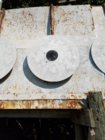To me, this means the smallest groups are about MOA but the rest are larger. What's the biggest group's sizes?Now, I'm not talking B/R accuracy but the .308 will shoot MOA or better if I do my part.
Install the app
How to install the app on iOS
Follow along with the video below to see how to install our site as a web app on your home screen.
Note: This feature may not be available in some browsers.
You are using an out of date browser. It may not display this or other websites correctly.
You should upgrade or use an alternative browser.
You should upgrade or use an alternative browser.
Optimal Accuracy Barrel Length - 6.5 x 47 Lapua?
- Thread starter Phil3
- Start date
Krieger has a bunch of 6.5s in stock at the moment. Check their inventory and I’m sure you can find something with no wait other than shipping.OK, thanks to all. I think I will most likely go for a 26". Probably a Brux, but perhaps any name brand cut-rifled barrel with correct profile (still working on that). - Phil
I will try to post some images of the 1k targets I have when I get home. Remember, the targets I shoot are 1 MOA bull or 10 ring and 2 MOA 5 ring. There are no sighters and no wind flags. Distances are at 6, 8, 9, and 1K from a bipod or bull bag. At the further distances maybe 1.5 MOA size, sometimes better sometimes worse. Mostly because of the wind. It definitely can't keep up with my Dasher.


Last edited:
There was some very interesting testing done in a giant warehouse in Texas a few decades back that came to the conclusion that 21.75" is the right length for maximum accuracy and precision, regardless of caliber. We're talking about shooting in the zero's here. That's when you're squeezing every last drop from the turnip.
There are a lot of reasons to use longer or shorter barrels. I like 26 inches for a gun I'm not carrying real far and shooting for fun. Hunting rifles get shorter barrels for maneuverability.
There are a lot of reasons to use longer or shorter barrels. I like 26 inches for a gun I'm not carrying real far and shooting for fun. Hunting rifles get shorter barrels for maneuverability.
That blows the socks off the OBT theory; right?There was some very interesting testing done in a giant warehouse in Texas a few decades back that came to the conclusion that 21.75" is the right length for maximum accuracy and precision, regardless of caliber. We're talking about shooting in the zero's here.
Could that be why are none of the benchrest many group aggregates are in the zeros?
Last edited:
Bart B. Here are a couple of the 1K targets I was referring to.....the black is 10 inches. If you look closely, you can see a 2nd, 2-MOA line. Only pics I could find from my 20 inch .308. Remember, no sighters, no wind flags...bipod or bulls bag. Not B/R....but a lot of fun!
That Hardrock?
That's about the same accuracy the best M1 and M14 match rifles did tested at 1000 with handloads in new cases.Bart B. Here are a couple of the 1K targets I was referring to.....the black is 10 inches. If you look closely, you can see a 2nd, 2-MOA line. Only pics I could find from my 20 inch .308. Remember, no sighters, no wind flags...bipod or bulls bag. Not B/R....but a lot of fun!
Bart, I would not think it blows the OBT theory. "Secrets of the Houston Warehouse" was a great story, due to the fact that I knew one of the gentlemen. The rifle that shot the tiny groups was a 22PPC. The 6PPC they shot also shot well, but with slightly larger groups. Jim Gilbert is the guy that mentions 21.75 inches being optimum. The reason for that is "duplication of the vibrations" from shot to shot. You never hear much about that word duplication. OBT still applies but 21.75 is optimum if you are not using a barrel tuner. Switching gears, you can also read up on Gene Beggs and "The Secrets of the West Texas Tunnel." Virgil King, the guy who owned the 22PPC that shot so well said this...quote"He found himself grieving over several humiliating encounters with shooting in Midland, Tx." The reason for the humiliation was the wind and the fact that through the years we have had many world class shooters in this area and still do. I own a 6PPC that will shoot one hole groups (.060--.100) without a tuner, but it will not do it every time. However, many of the 100/200 yd shooters run 21.75-22.0 inch barrels with tuners. Some use the tuner and leave the load the same and others have the tuner just to dampen the vibes and change the loads accordingly. Regardless of bullet, barrel length, or load, we still have to deal with the elements. If I only shot short ranges (100-500), then 21-22 inches with no tuner would probably be optimum. As you know we have trade offs. If 1,000 is where I'm shooting most, then I go with longer barrel. At 1,000 yards, every 100 fps counts. The wind will eat your lunch!That blows the socks off the OBT theory; right?
Could that be why are none of the benchrest many group aggregates are in the zeros?
Phil you will be good to go with 26-28 inch barrel. 6.5 x 47 will give you good velocity for long range and they will bughole at short ranges as many on here have already alluded to. Your original post said that accuracy was more important. 22 is a little short for 1,000 yards.
Every query I've made to mechanical engineers working with cantilever beam/barrel vibrations got the same response; each one has it's own resonant and harmonic frequencies that are very repeatable. Their amplitude varies with cartridge load but the frequencies stay the same because their profile and metallurgy stays the same.The reason for that is "duplication of the vibrations" from shot to shot.
That Warehouse barrel was no different.
How would a 26" 308 Win barrel shooting several 10 shot groups under 1.5" at 600 yards compare with that Houston Warehouse barrel? 'Tain't in the zeros but whaddya expect at 1800 feet.
Last edited:
Agree! Who knows...if that 308 were in a 600 yd long warehouse with absolutely no wind....it might shoot in the o's !!!Every query I've made to mechanical engineers working with cantilever beam/barrel vibrations got the same response; each one has it's own resonant and harmonic frequencies that are very repeatable. Their amplitude varies with cartridge load but the frequencies stay the same because their profile and metallurgy stays the same.
That Warehouse barrel was no different.
How would a 26" 308 Win barrel shooting several 10 shot groups under 1.5" at 600 yards compare with that Houston Warehouse barrel? 'Tain't in the zeros but whaddya expect at 1800 feet.
We still have to take our hats off to those guys! Even in a warehouse a 22PPC shooting .035 groups over and over again is pretty cool. They have shot some tiny groups in Gene's tunnel at Odessa as well. I think the 30BR is another neat deal! Talking about some small groups in the wind!!!!Every query I've made to mechanical engineers working with cantilever beam/barrel vibrations got the same response; each one has it's own resonant and harmonic frequencies that are very repeatable. Their amplitude varies with cartridge load but the frequencies stay the same because their profile and metallurgy stays the same.
That Warehouse barrel was no different.
How would a 26" 308 Win barrel shooting several 10 shot groups under 1.5" at 600 yards compare with that Houston Warehouse barrel? 'Tain't in the zeros but whaddya expect at 1800 feet.
Every query I've made to mechanical engineers working with cantilever beam/barrel vibrations got the same response; each one has it's own resonant and harmonic frequencies that are very repeatable. Their amplitude varies with cartridge load but the frequencies stay the same because their profile and metallurgy stays the same.
That Warehouse barrel was no different.
How would a 26" 308 Win barrel shooting several 10 shot groups under 1.5" at 600 yards compare with that Houston Warehouse barrel? 'Tain't in the zeros but whaddya expect at 1800 feet.
If you or anyone else is interested, here is a read on it. Worth the time, I think:
http://benchrest.com/showthread.php?97105-Secrets-of-the-Houston-Warehouse
It wasn't just 1 rifle or caliber that preferred 21.75 for the barrel length. It was 22s, 6mm, and 30 cals across many rifles. I'm not arguing the logic or physical reasons behind it, just like I'm not going to argue whether OBT is a useful ideology for improving repeatability across changing conditions. 21.75" length barrels were shown to shoot consistently very well across many guns and calibers in better controlled conditions than most of us have access to. If you are chasing ultimate accuracy, it helps to stand on the shoulders of those before you. If you're shooting more practically in real conditions, the edge that "magic" length gives you vanishes when the wind blows.
At 1,000 yards, every 100 fps counts. The wind will eat your lunch!
@Phil3 , it's honestly preference. You're shooting at all sorts of different distances and you don't appear to have a specific BR or F series class you're competing in so there are no rules. Rules usually drive the games people play with barrel length and contour; they have to make a specific weight. It hardly matters what you choose for barrel length and size cause you aren't bound by that. The rifle just needs to balance correctly and work comfortably for you.
Evan,
You are right that I will be shooting at different distances (due to ranges available and distance) and not competing, so no rules as you say. I was inclined to use a 24" - 26" barrel, with a .875 - .930" muzzle. From what I read here, something in this range should be fine. This length and contour will be heavy for sure, but doesn't matter to me. Less recoil, so not a bad thing.
Thank you.
Phil
You are right that I will be shooting at different distances (due to ranges available and distance) and not competing, so no rules as you say. I was inclined to use a 24" - 26" barrel, with a .875 - .930" muzzle. From what I read here, something in this range should be fine. This length and contour will be heavy for sure, but doesn't matter to me. Less recoil, so not a bad thing.
Thank you.
Phil
Similar threads
Upgrades & Donations
This Forum's expenses are primarily paid by member contributions. You can upgrade your Forum membership in seconds. Gold and Silver members get unlimited FREE classifieds for one year. Gold members can upload custom avatars.

Click Upgrade Membership Button ABOVE to get Gold or Silver Status.
You can also donate any amount, large or small, with the button below. Include your Forum Name in the PayPal Notes field.
To DONATE by CHECK, or make a recurring donation, CLICK HERE to learn how.

Click Upgrade Membership Button ABOVE to get Gold or Silver Status.
You can also donate any amount, large or small, with the button below. Include your Forum Name in the PayPal Notes field.
To DONATE by CHECK, or make a recurring donation, CLICK HERE to learn how.











